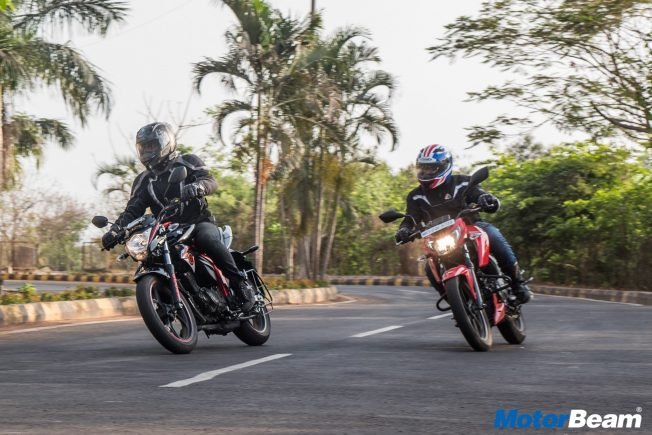We do a quick spec comparison between the Yamaha FZ V3 against the Suzuki Gixxer and TVS Apache 160 4V.
Yamaha just brought in the FZ V3.0, the third iteration of the company’s most successful street-fighter in India. But have they done enough to take on the segment’s best offering? We’ll find just that out, with a quick spec comparison.
Design – With revised styling the Yamaha FZ gets back the perfect balance between being aggressive, and looking virtuous. The new tank design along with a forward biased stance give it immense road presence. The FZ25 inspired headlamp set-up and new placement for the ignition key further adds to the street-fighter character. The Gixxer on the other hand despite being an older design, still manages to turn heads thanks to Suzuki’s dual-tone paint scheme and bold colours. Meanwhile, the Apache borrows design cues from the RTR 200 4V and the sharp styling is evident. However, some would complain on the same fact that TVS made the RTR 160 4V look like a cheaper version of the RTR 200 4V.
Although the Yamaha FZ looks the most exciting, one has to admit that the Gixxer carries a more mature design language and the Apache looks the sportiest. So, choosing between either of these based on design is purely a subjective matter as all of them have something different to offer.
Engine – The TVS Apache RTR 160 4V has the most advanced set-up among the bikes here. Carrying a 4-valve head, this motor produces 16.8 PS of power and 14.8 Nm of torque. The advantage on paper is evident on the road as well. The Apache is the fastest motorcycle among the trio. The engine on the RTR is one of the most engaging units and offers tremendous performance. The Suzuki Gixxer despite looking feeble on paper with a 2-valve head equipped engine, offers good amount of excitement. The Gixxer produces 14.8 PS of power and 14 Nm of torque but Suzuki has tuned to motor on the post BS4 models to a calmer state.
The Yamaha FZ V3 on the other hand is a more commuter-oriented motorcycle making the least power at 13.2 PS and 12.8 Nm of torque. Yamaha has reworked upon fuel maps on the V3.0 to deliver better low-end performance and a stronger top-end than before. This is also evident in the acceleration figures. The FZ is now faster than it was ever before to hit the ton. All the motorcycles are very frugal, but the Yamaha with the most refined fuel injected motor returns the highest fuel economy with the Apache coming in second closely followed by the Gixxer.
Price – All these motorcycles are priced very close to each other. The FZ V3.0 being the most expensive motorcycle here, justifies its price with a smoother engine and the best build quality to boast off. Not to forget Yamaha’s unmatched reliability and strong after-sales network. The Gixxer being cheaper to the FZ by almost Rs. 8000/- packs a well-balanced setup. The TVS on the other hand is the cheapest motorcycle here at Rs. 1.03 lakhs. It is about Rs. 2000/- cheaper than the Gixxer and carries the sportiest ergonomics of the lot.
Verdict – The Yamaha FZ V3 attracts commuters and that is about it. Although it is quicker than its predecessor, the Yamaha is not intended to carry forward the legacy created by the original FZ. The FZ deserved a stronger engine but seems like the Japanese automaker is saving that up for the MT-15. Meanwhile, the engine on the Apache is a no brainer! Smooth, powerful, exciting and efficient. But what really takes the matter ahead for the Gixxer is the most sorted out chassis, suspension and riding dynamics. While you can’t go wrong with either of these three motorcycles, choosing one is firmly based on the usability the rider is intending for.

